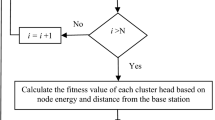Abstract
In wireless sensor networks (WSNs), designing a stable, low-power routing protocol is a major challenge because successive changes in links or breakdowns destabilize the network topology. Therefore, choosing the right route in this type of network due to resource constraints and their operating environment is one of the most important challenges in these networks. Therefore, the main purpose of these networks is to collect appropriate routing information about the environment around the network sensors while observing the energy consumption of the sensors. One of the important approaches to reduce energy consumption in sensor networks is the use of the clustering technique, but in most clustering methods, only the criterion of the amount of energy of the cluster or the distance of members to the cluster has been considered. Therefore, in this paper, a method is presented using the firefly algorithm and using the four criteria of residual energy, noise rate, number of hops, and distance. The proposed method called EM-FIREFLY is introduced which selects the best cluster head with high attractiveness and based on the fitness function and transfers the data packets through these cluster head to the sink. The proposed method is evaluated with NS-2 simulator and compared with the algorithm-PSO and optimal clustering methods. The evaluation results show the efficiency of the EM-FIREFLY method in maximum relative load and network lifetime criteria compared to other methods discussed in this article.







Similar content being viewed by others
References
Srinivasa Gowda A, Annamalai NM (2020) Hybrid salp swarm–firefly algorithm-based routing protocol in wireless multimedia sensor networks. Int J Commun Sys 34(3):e4633
Fotohi R, Bari SF (2020) A novel countermeasure technique to protect WSN against denial-of-sleep attacks using firefly and Hopfield neural network (HNN) algorithms. J Supercomput 76(9):1–27
Rao AN, Naik R, Devi N (2020) On Maximizing the Coverage and Network Lifetime in Wireless Sensor Networks Through Multi-Objective Metaheuristics. J Inst Eng (India): Series B. https://doi.org/10.1007/s40031-020-00516-y
Shahbaz AN, Barati H, Barati A (2020) Multipath routing through the firefly algorithm and fuzzy logic in wireless sensor networks. Peer-to-Peer Netw Appl. https://doi.org/10.1007/s12083-020-01004-2
Sodhro AH, Zongwei L, Pirbhulal S, Sangaiah AK, Lohano S, Sodhro GH (2020) Power-management strategies for medical information transmission in wireless body sensor networks. IEEE Consumer Electronics Magazine 9(2):47–51
Patil VS, Mane YB, Deshpande S (2019) FPGA based power saving technique for sensor node in wireless sensor network (WSN). Computational Intelligence in Sensor Networks. Springer, Berlin, Heidelberg, pp 385–404
Bengheni A, Didi F, Bambrik I (2019) EEM-EHWSN: Enhanced energy management scheme in energy harvesting wireless sensor networks. Wireless Netw 25(6):3029–3046
Tilahun SL, Ngnotchouye JMT, Hamadneh NN (2019) Continuous versions of firefly algorithm: A review. Artif Intell Rev 51(3):445–492
Selvakumar B, Muneeswaran K (2019) Firefly algorithm based feature selection for network intrusion detection. Comput Security 81:148–155
Alrashidi M, Nasri N, Khediri S et al (2020) Energy-Efficiency Clustering and Data Collection for Wireless Sensor Networks in Industry 4.0. J Ambient Intell Human Comput. https://doi.org/10.1007/s12652-020-02146-0
Manshahia MS (2015) A firefly based energy efficient routing in wireless sensor networks. African J Comput ICT 8(4):27–32
Ghorbel, M. B., Rodriguez-Duarte, D., Ghazzai, H., Hossain, M. J., & Menouar, H. (2018, June). Energy efficient data collection for wireless sensors using drones. In 2018 IEEE 87th Vehicular Technology Conference (VTC Spring) (pp. 1–5). IEEE.
Saleh IA (2016) Apply Firefly Optimization to Increase Period Routing Algorithm in Wireless Sensor Networks. Int J Comput Netw Technol 4(01):51–58
Ghosh N, Banerjee I, Sherratt RS (2019) On-demand fuzzy clustering and ant-colony optimisation based mobile data collection in wireless sensor network. Wireless Netw 25(4):1829–1845
Jun JH, Xie B, Agrawal DP (2009) Wireless mobile sensor networks: Protocols and mobility strategies. Guide to wireless sensor networks. Springer, London, pp 607–634
Diwakaran S, Perumal B, Devi KV (2019) A cluster prediction model-based data collection for energy efficient wireless sensor network. J Supercomput 75(6):3302–3316
Zhao H, Guo S, Wang X, Wang F (2015) Energy-efficient topology control algorithm for maximizing network lifetime in wireless sensor networks with mobile sink. Applied Soft Comput 34:539–550
Li G, Chen H, Peng S, Li X, Wang C, Yu S, Yin P (2018) A collaborative data collection scheme based on optimal clustering for wireless sensor networks. Sensors 18(8):2487
Soundari AG, Jyothi VL (2020) Energy efficient machine learning technique for smart data collection in wireless sensor networks. Circuits, Syst Signal Process 39(2):1089–1122
Huang H, Huang C, Ma D (2019) The cluster based compressive data collection for wireless sensor networks with a mobile sink. AEU-Int J Electronics Commun 108:206–214
Sohail M, Khan S, Ahmad R, Singh D, Lloret J (2019) Game theoretic solution for power management in IoT-based wireless sensor networks. Sensors 19(18):3835
Maheshwari P, Sharma AK, Verma K (2021) Energy efficient cluster based routing protocol for WSN using butterfly optimization algorithm and ant colony optimization. Ad Hoc Netw 110:102317
Fotohi R, Nazemi E, Aliee FS (2020) An Agent-Based Self-Protective Method to Secure Communication between UAVs in Unmanned Aerial Vehicle Networks. Veh Commun 26:100267
Huamei, Q., Chubin, L., Yijiahe, G., Wangping, X., & Ying, J. An energy‐efficient non‐uniform clustering routing protocol based on improved shuffled frog leaping algorithm for wireless sensor networks. IET Communications.
Faraji-Biregani M, Fotohi R (2020) Secure communication between UAVs using a method based on smart agents in unmanned aerial vehicles. J Supercomput. https://doi.org/10.1007/s11227-020-03462-0
Jamali S, Fotohi R (2017) DAWA: Defending against wormhole attack in MANETs by using fuzzy logic and artificial immune system. J Supercomput 73(12):5173–5196
Gupta P, Tripathi S, Singh S (2021) Energy-Efficient Routing Protocols for Cluster-Based Heterogeneous Wireless Sensor Network (HetWSN)—Strategies and Challenges: A Review. Data Anal Manag. https://doi.org/10.1007/978-981-15-8335-3_65
Author information
Authors and Affiliations
Corresponding authors
Additional information
Publisher's Note
Springer Nature remains neutral with regard to jurisdictional claims in published maps and institutional affiliations.
Rights and permissions
About this article
Cite this article
Pakdel, H., Fotohi, R. A firefly algorithm for power management in wireless sensor networks (WSNs). J Supercomput 77, 9411–9432 (2021). https://doi.org/10.1007/s11227-021-03639-1
Accepted:
Published:
Issue Date:
DOI: https://doi.org/10.1007/s11227-021-03639-1




